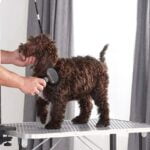Table of Contents
Walking your dog should be an enjoyable experience, but it can be challenging if your dog constantly pulls on the leash. Understanding how to stop a dog from pulling on the leash requires patience, consistency, and the right techniques. This guide provides seven proven tips to help you and your dog enjoy peaceful, pull-free walks.

Understanding Why Dogs Pull on the Leash
Before addressing the issue, it’s essential to understand why dogs pull on the leash. Common reasons include:
- Excitement: Dogs are excited to explore their surroundings and may pull to get there faster.
- Natural Instinct: Pulling is a natural behavior for dogs, especially those bred for pulling or herding.
- Lack of Training: Without proper leash training, dogs may not understand what is expected of them during walks.
1. Use the Right Equipment
Using the appropriate equipment can make a significant difference in managing your dog’s pulling behavior:
- Harness: A no-pull harness can help distribute pressure evenly and discourage pulling.
- Head Collar: A head collar can provide better control by guiding your dog’s head and reducing pulling.
- Leash: Use a standard 4-6 foot leash. Avoid retractable leashes, which can encourage pulling.
2. Teach Loose Leash Walking
Loose leash walking is a fundamental skill that helps prevent pulling. Here’s how to teach it:
- Start Indoors: Begin training in a distraction-free environment like your home.
- Reward Calm Behavior: Reward your dog with treats and praise when they walk calmly by your side without pulling.
- Stop and Go: If your dog starts to pull, stop walking and wait until they return to your side. Resume walking once the leash is loose.
3. Use Positive Reinforcement
Positive reinforcement encourages your dog to repeat desired behaviors. Consistently rewarding your dog for walking without pulling is key:
- Treats: Use high-value treats to reward your dog for walking beside you without pulling.
- Verbal Praise: Use enthusiastic verbal praise to reinforce good behavior.
- Consistency: Be consistent with rewards to help your dog understand what is expected.
4. Practice in Different Environments
Gradually introduce your dog to different environments to ensure they can walk nicely on a leash regardless of distractions:
- Start Slow: Begin with quiet, familiar areas before progressing to busier locations.
- Increase Distractions Gradually: Gradually expose your dog to more distractions, such as other dogs, people, and traffic.
- Maintain Control: Continue to use positive reinforcement and stop-and-go techniques in different environments.
5. Keep Training Sessions Short and Fun
Training should be enjoyable for both you and your dog. Keep sessions short to maintain your dog’s interest and enthusiasm:
- Short Sessions: Aim for 5-10 minute training sessions to prevent boredom and frustration.
- End on a Positive Note: Always end training sessions with a positive experience, such as a favorite game or treat.
- Frequent Breaks: Take frequent breaks to let your dog relax and process what they’ve learned.
6. Be Patient and Consistent
Training a dog to stop pulling on the leash requires patience and consistency. Progress may be slow, but persistence is key:
- Stay Calm: Remain calm and patient, even if your dog continues to pull. Frustration can hinder progress.
- Consistent Commands: Use the same commands and techniques consistently to avoid confusing your dog.
- Regular Training: Practice leash training regularly to reinforce good behavior and prevent setbacks.
7. Seek Professional Help if Needed
If you’re struggling to manage your dog’s pulling behavior, seeking professional help can be beneficial:
- Professional Trainer: A professional dog trainer can provide personalized guidance and techniques to address pulling.
- Behaviorist: If your dog’s pulling is linked to behavioral issues, a certified animal behaviorist can help.
- Group Classes: Consider enrolling in group training classes for additional support and socialization opportunities.
Conclusion on How to Stop a Dog from Pulling on the Leash
Learning how to stop a dog from pulling on the leash involves understanding the reasons behind the behavior and implementing effective training techniques. By using the right equipment, teaching loose leash walking, practicing positive reinforcement, and being patient and consistent, you can enjoy peaceful, pull-free walks with your dog. If needed, seek professional help to address persistent issues. For more tips on dog training and behavior, visit the ASPCA and AKC.
FAQs on How to Stop a Dog from Pulling on the Leash
Why does my dog pull on the leash?
Dogs pull on the leash for various reasons, including excitement, natural instincts, and lack of proper training. Understanding the cause can help address the behavior.
What type of leash is best for a dog that pulls?
A standard 4-6 foot leash is recommended for better control. Avoid retractable leashes, as they can encourage pulling and make training difficult.
How can I teach my dog to walk without pulling?
Teach loose leash walking by rewarding your dog for walking calmly by your side and using stop-and-go techniques when they pull. Consistency and positive reinforcement are key.
Are no-pull harnesses effective?
Yes, no-pull harnesses can be effective in reducing pulling by distributing pressure evenly and discouraging the behavior. Combine them with proper training for the best results.
How long does it take to train a dog to stop pulling on the leash?
The time it takes to train a dog to stop pulling on the leash varies depending on the dog’s age, breed, and previous training. Consistent training over several weeks to months is typically required.
When should I seek professional help for my dog’s leash pulling?
If you’re struggling to manage your dog’s pulling behavior despite consistent training, consider seeking help from a professional dog trainer or behaviorist for personalized guidance.











